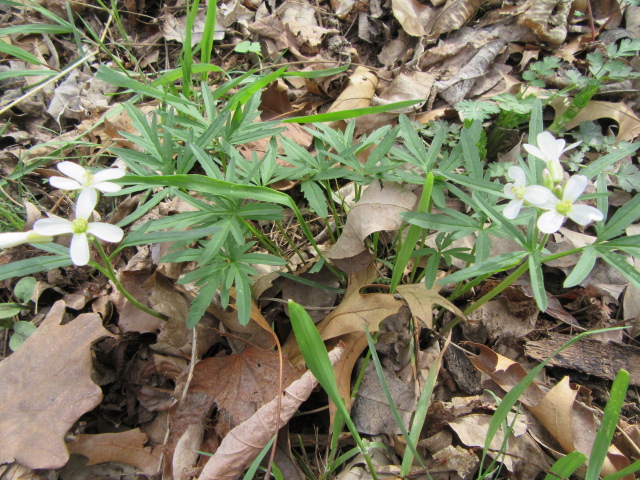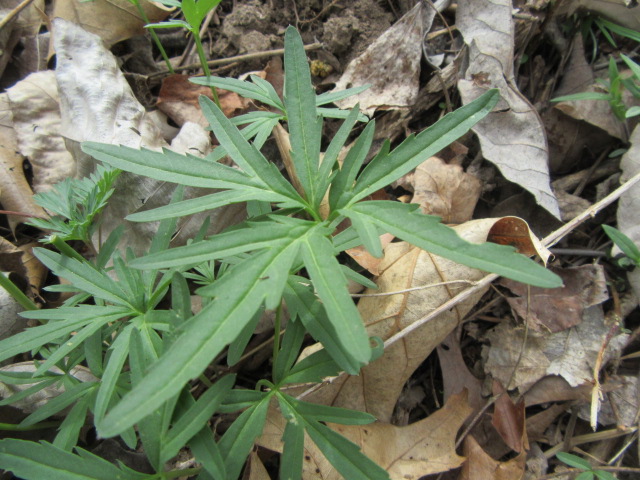
Cardamine concatenata (Cut-Leaved Toothwort) on 4-20-22, #870-1.
Cut-Leaved Toothwort, Cutleaf Toothwort, Crow’s Toes, Pepper Root
Cardamine concatenata
kar-DAM-ih-nee kon-kan-teh-NAH-tuh
Synonyms of Cardamine concatenata (13) (Updated on 12-6-23 from Plants of the World Online: Cardamine laciniata (Muhl. ex Willd.) Alph.Wood (1870)(nom. illeg.), Cardamine laciniata var. integra O.E.Schulz (1903), Cardamine laciniata f. minor (DC.) O.E.Schulz (1903), Dentaria laciniata Muhl. ex Willd. (1800), Dentaria concatenata Michx. (1803), Dentaria laciniata f. albiflora Louis-Marie (1940), Dentaria laciniata var. alterna Farw. (1930), Dentaria laciniata var. coalescens Fernald (1938), Dentaria laciniata f. hexifolia Wolden (1917), Dentaria laciniata var. integra (O.E.Schulz) Fernald (1908), Dentaria laciniata var. latifolia Farw. (1930), Dentaria laciniata var. minor DC. (1821), Dentaria laciniata var. opposita Farw. (1930)
Cardamine concatenata (Michx.) O.Schwarz is the accepted scientific name for this species It was named and described as such by Otto Karl Anton Schwarz in Repertorium Specierum Novarum Regni Vegetabilis in 1939. It was first named and described as Dentaria concatenata by André Michaux in Flora Boreali-Americana in 1803.
The genus, Cardamine L., was named and described by Carl von Linnaeus in the second volume of the first edition of Species Plantarum in 1753.
As of 12-6-23 when this page was last updated, Plants of the World Online lists 263 species in the Cardamine genus. It is a member of the plant family Brassicaceae with 346 genera. Those numbers could change as updates are made on POWO.

Distribution map of Cardamine concatenata from Plants of the World Online. Facilitated by the Royal Botanic Gardens, Kew. Published on the Internet; http://www.plantsoftheworldonline.org/. Retrieved on August 3, 2022.
The above distribution map for Cardamine concatenata is from Plants of the World Online. Areas in green are where the species is native. The map on the USDA Plants Database is the same and also includes North and South Dakota.
Some websites may use Dentaria laciniata as the scientific name…
The map on iNaturalist shows where members have made observations. Anyone can join and it is a great website to confirm and share your observations. The maps on iNaturalist are continually updated as members post new observations.
THERE ARE SEVERAL LINKS AT THE BOTTOM OF THE PAGE FOR FURTHER READING AND TO HELP WITH A POSITIVE ID.

Cardamine concatenata (Cut-Leaved Toothwort) on 4-23-20, #690-18.
I was wildflower hunting on a friend’s farm in a secluded wooded area on April 23, 2020. There were many species of wildflowers I hadn’t seen before including a cluster of neat plants next to a tree close to the top of a steep bank along a creek. There were no flowers at the time and when I went back later I couldn’t even find them. I was able to identify the species as Cardamine concatenata just from the leaves. I went one time, maybe in 2021, after a big storm and there had been kind of a landslide where water had rushed down the bank.

Cardamine concatenata (Cut-Leaved Toothwort) on 4-20-22, #870-2.
Then, I went back on April 20, 2022, and to my surprise, the same hillside was LOADED and they were scattered all along the bank of the creek! You just never know from one year to the next how habitats can change.
Cardamine concatenata is a perennial wildflower in the plant family Brassicaceae. It is found throughout Missouri and the eastern half of North America. They are easily identified by their foliage and 4-petaled white flowers in the spring. They also have a rather interesting root system which is an elongated, fleshy, jointed, and knobby rhizome.
This species can be found growing in wooded areas along streambanks and other wooded areas where the soil is moist with plenty of leaf litter. They start flowering before the leaves on the trees come out in March and may continue to flower until May. Growing to about 12 inches tall, Cardamine concatenata goes from emergence to flowering, fruiting, and then dormancy in four to five weeks.

Cardamine concatenata (Cut-Leaved Toothwort) on 4-20-22, #870-5. This photo shows how the leaf petioles emerge from the rhizome.
It all begins with the odd rhizomes from which several leaf petioles (leaf stems) grow directly from. Let me see if I can get this straight… First, the rhizomes send up what some sites call fertile shoots, which become long petioles that grow whorls of three leaves, or maybe only 2 leaves that grow alternate one another (meaning one is a little higher than the other).

Cardamine concatenata (Cut-Leaved Toothwort) on 4-20-22, #870-4.
Right above the leaf node grows the flower stem (peduncle) that terminates in a cluster of 6-10 flowers. Basal leaves also grow from the rhizomes from a single petiole (leaf stem) and they only produce one leaf and NO flowers. Some sites say the basal leaves are usually “absent” during flowering, and others say they grow AFTER flowering is complete. Well, folks, in 2022 I photographed both types of leaves during flowering. The basal leaves store energy for the next season’s growth. Shortly after flowering, the plants go dormant.

Cardamine concatenata (Cut-Leaved Toothwort) on 4-23-20, #690-19. Notice the Dicentra cucullaria (Dutchman’s Breeches) coming up in the top center of the photo.
Basal leaves in “most” species are leaves that grow first and are usually larger than leaves farther up the stem. In this case, there are no stems. The basal leaves emerge from petioles growing from the rhizomes. One site calls these rhizomal leaves. They are the same basic shape as the whorl of leaves some sites call stem leaves or cauline leaves, only they are smaller. Leaves are up to around 3” long and wide and have 3 leaflets (which sometimes appear to be 5).
 Cardamine concatenata (Cut-Leaved Toothwort) on 4-20-22, #870-6. This photo shows a whorl of three leaves.
Cardamine concatenata (Cut-Leaved Toothwort) on 4-20-22, #870-6. This photo shows a whorl of three leaves.
While leaf shapes can be somewhat variable, they are palmately lobed, with their margins coarsely toothed. I could write a more elaborate description, but that is a simple version.

Cardamine concatenata (Cut-Leaved Toothwort) on 4-23-20, #690-20. This photo shows the underside of the leaf.
The petioles of the basal leaves have grooves toward the tip, while the petioles of whorled leaves are round without grooves.

Cardamine concatenata (Cut-Leaved Toothwort) on 4-20-22, #870-9.
As I mentioned previously, the peduncle (flower stem) grows from the node where the whorl of leaves grows or where the upper leaf grows if there are two. It is like the peduncle is an extension of the leaf petiole.

Cardamine concatenata (Cut-Leaved Toothwort) on 4-20-22, #870-10.
Usually from 3-10 flowers are produced in a cluster with fairly long peduncles. The bell-shaped flowers have 4 white to light pink petals and are surrounded by 4 green to pinkish-tinged sepals. There are 6 stamens with yellow filaments and yellow anthers. The pistil includes an ovary with an erect style and a globose stigma.
Plants may start flowering in April and continue until May in my neck of the woods in west-central Missouri. The flowers are pollinated by several bee species and a few butterflies.

The above photo of Cardamine concatenata fruit is from the Missouri Plants website. Missouri Plants is published on the internet at http://www.missouriplants.com/index.html. Photo used by permission and retrieved on February 3, 2024.
Flowers are replaced by fruit, called siliques, that are approximately 1 1/2” wide and 1/8” long. Pods may have up to 10 or so brown seeds arranged in a single row. Once the pods dry, they twist to eject the seeds.
The above photo of the fruit is from the Missouri Plants website until I can take a few photos of my own. Missouri Plants is one of my favorite wildflower websites for confirming species I have observed on the farm and in other areas. Missouri Plants is provided by the Missouri Botanical Garden.
If you want to plant seeds, they should be sown fresh as they lose viability quickly in storage. They need cold stratification of around 60 days, which Mother Nature will handle over the winter. They can also be grown from rhizomes, but they need to be planted in a suitable location similar to their natural habitat. Moist organically rich soil with plenty of leaf litter… Plant horizontally just below the surface.
Well, writing descriptions of Cardamine concatenata was certainly entertaining. In 2024, I need to return to the woods and take more photos. Hopefully, there will be A LOT like there was in 2022.
I live on a small farm in Windsor, Missouri where I enjoy gardening, collecting plants, and identifying wildflowers. The farm is in Pettis County but Henry County is across the street, and Benton and Johnson aren’t far away. I have grown over 500 different plants and identified over 250 species of wildflowers (most have pages listed on the right side of the page). I am not an expert, botanist, or horticulturalist. I just like growing, photographing, and writing about my experience. I rely on several websites for ID and a few horticulturalists I contact if I cannot figure them out. Wildflowers can be somewhat variable from location to location, so sometimes it gets a bit confusing. If you see I have made an error, please let me know so I can correct what I have written.
I hope you found this page useful and be sure to check the links below for more information. They were written by experts and provide much more information. Some sites may not be up-to-date but they are always a work in progress. If you can, I would appreciate it if you would click on the “Like” below and leave a comment. It helps us bloggers stay motivated. You can also send an email to me at thebelmontrooster@yahoo.com. I would enjoy hearing from you especially if you notice something is a bit whacky
FOR FURTHER READING:
PLANTS OF THE WORLD ONLINE (GENUS/SPECIES)
INTERNATIONAL PLANT NAMES INDEX (GENUS/SPECIES)
TROPICOS (GENUS/SPECIES)
FLORA OF MISSOURI (GENUS/SPECIES)
FLORA OF NORTH AMERICA (GENUS/SPECIES)
WORLD FLORA ONLINE (GENUS/SPECIES)
WIKIPEDIA (GENUS/SPECIES)
USDA PLANTS DATABASE
MISSOURI PLANTS
U.S. FOREST SERVICE
iNATURALIST
WILDFLOWER SEARCH
DAVE’S GARDEN
ARKANSAS NATIVE PLANT SOCIETY
ILLINOIS WILDFLOWERS
MINNESOTA WILDFLOWERS
KANSAS WILDFLOWERS AND GRASSES
NORTH CAROLINA STATE UNIVERSITY
IOWA PLANTS
FRIENDS OF THE WILDFLOWER GARDEN
GO BOTANY
MARYLAND BIODIVERSITY PROJECT
LADY BIRD JOHNSON WILDFLOWER CENTER
FLORA FINDER
GARDENIA
WISCONSIN HORTICULTURE
FLORA OF PENNSYLVANIA
WISCONSIN MASTER GARDENER
SIENet
NOTE: The data (figures, maps, accepted names, etc.) may not match on these websites. It depends on when and how they make updates and when their sources make updates. Some websites have hundreds and thousands of species to keep up with. Accepted scientific names change periodically and can be hard to keep with. Some of the links may use a name that is a synonym on other sites. In my opinion, Plants of the World Online by Kew is one of the most reliable and up-to-date plant databases and they make updates regularly. I make updates “at least” once a year and when I write new pages or add new photos but I do get behind. We are all a work in progress. 🙂

Cardamine concatenata (Cut-Leaved Toothwort) on 4-23-20, #690-21.

Cardamine concatenata (Cut-Leaved Toothwort) on 4-20-22, #870-3.

Cardamine concatenata (Cut-Leaved Toothwort) on 4-20-22, #870-7.

Cardamine concatenata (Cut-Leaved Toothwort) on 4-20-22, #870-8.

Cardamine concatenata (Cut-Leaved Toothwort) on 3-31-24, #981-1.

Cardamine concatenata (Cut-Leaved Toothwort) on 3-31-24, #981-2.